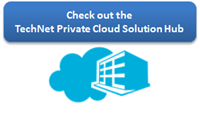IPv6 and Your Private Cloud
 When architecting your private cloud infrastructure, one of components you need to give attention to is the networking infrastructure that supports connectivity between the devices within your private cloud, and between tenants of the private cloud and external locations, such as your public cloud assets.
When architecting your private cloud infrastructure, one of components you need to give attention to is the networking infrastructure that supports connectivity between the devices within your private cloud, and between tenants of the private cloud and external locations, such as your public cloud assets.
Not only do you need to consider the architecture of your virtual networks and switches and how you approach resiliency and self-service for the network architecture, you also need to consider the versions of the Internet Protocol you need to support.
This is a critical consideration. The reason for this is that private cloud not only represents a new way of thinking about how you provide services to the consumers of your cloud-based offerings, you also can think of private cloud as a way to “reboot” or start over – to enable you to architect, design, plan and deploy the services delivery infrastructure you always wanted, but never was able to get with your current traditional data center.
In this post by Darryl Kegg he explains that while most organizations that are thinking about private cloud are very comfortable with cutting edge advances in virtualization, but are missing out in a key cloud enabler in IPv6. I think you’ll like this post and that it get you to thinking about architecting IPv6 into your private cloud solutions. –Tom.
 “How do I get to the cloud?”, “Why do I need to be in the cloud?”, “What should I be doing today to get ready for the cloud?”, “Will my environment even work with the cloud?”
“How do I get to the cloud?”, “Why do I need to be in the cloud?”, “What should I be doing today to get ready for the cloud?”, “Will my environment even work with the cloud?”
These are all questions I get on a semi-regular basis as I talk to colleagues, customers and random passers-by as I go about my day to day activities. Whether we’re talking about Office 365, Exchange co-existence, virtualization, networking or even the next evolution of the desktop, the conversation always seems to come back to the cloud. Companies today are getting back into the swing of IT things, whether it’s a resurgence in IT investments as the economy improves for some, or the knowledge that the next evolution of the desktop and server will require an overhaul (or at the very least a redesign and paradigm shift) of their overall IT infrastructure, everyone wants to make sure they don’t inadvertently start down a path that limits their cloud options.
I am by no means a cloud expert, and in all my travels I’ve seemed to misplace my crystal ball, but to me there’s one obvious IT infrastructure investment that shouldn’t be overlooked and that’s IPv6.
Almost every person I talk to is intimately familiar with virtualization and all the options available today. In many cases it’s nearly like a political debate, and unless I’m being asked for implementation assistance I try to stay out of the “which one is better” conversation. I could go on for pages on the virtues of virtualization, and I’d also bet there’s quite a few blogs (hundreds really) that already do, as well as argue the different vendors and their pros and cons. Most IT professionals today understand the need for virtualization, and the fact that it’s a key staple in any shift to the cloud, but that’s normally where the “cloud” focus ends.
Why IPv6?
What I don’t see is customers actively trying to understand or implement IPv6. Most are removing IPv6 from their server and workstation images (or trying to), and a few others are simply trying to shoe-horn IPv6 into their environment so they can get DirectAccess to work, but nobody seems to be sitting down and working on a full IPv6 design. This is a mistake, and I believe a bit short-sighted.
IPv6 holds many advantages over traditional IPv4, things like extended addressing, embedded IP security, elimination of NAT, mobility, auto-configuration, the list goes on and on. And while the road to independence paved by IPv6 might be long and arduous, with short-term implementation costs and challenges, not to mention a shift in the way most IT pros think about networking, IPv6 provides numerous business values. Since IPv6 is the primary technology focus for public networks, investments in IPv6 endpoints are likely to have a longer life-cycle. Additionally, the auto-configuration features of IPv6 means improved manageability and reduced administrative overhead, as well as flexibility and simplicity in address plan management.
What Does This Have to Do With Private Cloud?
So what does this mean to you, and how does it get you to the cloud?
Since Windows Server 2008 and Windows Vista were released, Microsoft has included support for IPv6, this means that organizations that have migrated their servers and workstations to the latest OS are already on the path to IPv6. It’s simply a matter of setting up the addressing scheme, IPv6 DNS and network equipment to begin adopting IPv6. In fact there’s a great book from SAMS Publishing called Windows Server 2008R2 Unleashed that dedicates a good deal of time to configuring IPv6 in a Windows environment.
While the bulk of the infrastructure upgrade lies in the network endpoints, it’s important to understand IPv6 and how to properly configure it for your environment. Only then can you start to migrate your perimeter to IPv6.
Ok, so now what?
I would strongly urge you to learn more about IPv6, understand what it offers and start thinking about how you can implement it in your environment. Even though the transition is not something that can occur overnight, you will find that if you start planning your upgrade and migration activities with IPv6 in mind you will be that much further ahead of the curve when your ISP starts offering IPv6 space, your virtualization vendor starts offering native IPv6 support and the cloud starts knocking on your door.
Author:
Darryl Kegg | Senior Consultant | Microsoft Corporation | 630.725.4106 | darryl.kegg@microsoft.com
Editor:
Tom
Tom Shinder
tomsh@microsoft.com
Principal Knowledge Engineer, SCD iX Solutions Group
Follow me on Twitter: https://twitter.com/tshinder
Facebook: https://www.facebook.com/tshinder
